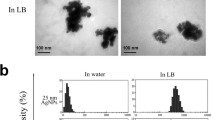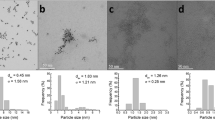Abstract
To help fill the knowledge gap regarding the potential human health impacts of food pigment TiO2, a comparative toxicity study was performed on a food-grade TiO2 (f-TiO2), a bulk TiO2 (b-TiO2), and a nano-sized TiO2 (Degussa P25), and in the nematode Caenorhabditis elegans. Acute phototoxicity and chronic toxicity effects including reproduction, lifespan, and vulval integrity were evaluated. The f-TiO2, b-TiO2, and P25 had a primary particle size (size range) of 149 (53–308) nm, 129 (64–259) nm, and 26 (11–52) nm, respectively. P25 showed the greatest phototoxicity with a 24-h LC50 of 6.0 mg/L (95% CI 5.95, 6.3), followed by the f-TiO2 (LC50 = 6.55 mg/L (95% CI 6.35, 6.75)), and b-TiO2 was the least toxic. All three TiO2 (1–10 mg/L) induced concentration-dependent effects on the worm’s reproduction, with a reduction in brood size by 8.5 to 34%. They all caused a reduction of worm lifespan, accompanied by an increased frequency of age-associated vulval integrity defects (Avid). The impact on lifespan and Avid phenotype was more notable for P25 than the f-TiO2 or b-TiO2. Ingestion and accumulation of TiO2 particles in the worm intestine was observed for all three materials by light microscopy. These findings demonstrate that the food pigment TiO2 induces toxicity effects in the worm and further studies are needed to elucidate the human health implication of such toxicities.







Similar content being viewed by others
References
Angelstorf J, Ahlf W, Kammer F, Heise S (2014) Impact of particle size and light exposure on the effects of TiO2 nanoparticles on Caenorhabditis elegans. Environ Toxicol Chem 33(10):2288–2296
Auffan M, Rose J, Bottero JY, Lowry GV, Jolivet JP, Wiesner MR (2009) Towards a definition of inorganic nanoparticles from an environmental, health and safety perspective. Nat Nanotechnol 4:634–641
Cattaneo A, Gornati R, Chiriva-Internati M, Bernardini G (2009) Ecotoxicology of nanomaterials: the role of invertebrate testing. Invertebr Surviv J 6(1):78–97
Dudefoi W, Moniz K, Allen-Vercoe E, Ropers MH, Walker VK (2017) Impact of food grade and nano-TiO2 particles on a human intestinal community. Food Chem Toxicol 106:242–249
European Food Safety Authority (2004) Opinion of the Scientific Panel on food additives, flavourings, processing aids and materials in contact with food on a request from the commision related to the safety in use of rutile titanium dioxide as an alternative to the presently permitted anatase form. EFSA J 163:1–12
Gonzalez-Moragas L, Maurer LL, Harms VM, Meyer JN, Laromaine A, Roig A (2017) Materials and toxicological approaches to study metal and metal-oxide nanoparticles in the model organism Caenorhabditis elegans. Mater Horiz 4(5):719–746
Grand View Research (2017) Titanium Dioxide (TiO2) market analysis by application (Paints & Coatings, Plastics, Paper & Pulp, Cosmetics), by region (North America, Europe, Asia Pacific, CSA, MEA), and segment forecasts, 2018–2025. Report ID: 978-1-68038-705-6
Halimi SU, Bakar NFA, Ismail SN, Hashib SA, Naim MN (2014) 5th nanoscience and nanotechnology symposium. American Institute of Physics Inc. 1586:57–62
Hotze EM, Phenrat T, Lowry GV (2010) Nanoparticle aggregation: challenges to understanding transport and reactivity in the environment. J Environ Qual 39(6):1909–1924
Hurum DC, Agrios AG, Gray KA (2003) Explaining the enhanced photocatalytic activity of Degussa P25 mixed-phase TiO2 using EPR. J Phys Chem B 107(19):4545–4549
Hussain S, Boland S, Baeza-Squiban R, Hamel LC, Thomassen JA, Martens MA, Billon-Galland J, Fleury-Feith F, Moisan A, Pairon JC, Marano F (2009) Oxidative stress and proinflammatory effects of carbon black and titanium dioxide nanoparticles: role of particle surface area and internalized amount. Toxicology 260(1-3):142–149
Iannarelli L, Giovannozzi AM, Morelli F, Viscotti F, Bigini P, Maurino V, Spoto G, Martra G, Ortel E, Hodoroaba VD, Rossi AM, Diomede L (2016) Shape engineered TiO2 nanoparticles in Caenorhabditis elegans: a Raman imaging based approach to assist tissue-specific toxicological studies. RSC Adv 6(74):70501–70509
IARC Monographs on the evaluation of carcinogenic risks to humans (2010) Vol 93. Carbon black, titanium dioxide and Talc. Lyon, France
Kahru A, Dubourguier HC (2010) From ecotoxicology to nanoecotoxicology. Toxicology 269(2-3):105–119
Kehrer JP, Robertson JD, Smith CV (2010) 1.14 - free radicals and reactive oxygen species. In: CA MQ (ed) Comprehensive Toxicology, 2nd edn. Elsevier, Oxford, pp 277–307
Khare P, Sonane M, Pandey R, Ali S, Gupta KC, Satish A (2011) Adverse effects of TiO2 and ZnO nanoparticles in soil nematode, Caenorhabditis elegans. J Biomed Nanotechnol 7(1):116–117
Kiyama Y, Miyahara K, Ohshima Y (2012) Active uptake of artificial particles in the nematode Caenorhabditis elegans. J Exp Biol 215(Pt 7):1178–1183
Klaine SJ, Alvarez PJ, Batley GE, Fernandes TF, Handy RD, Lyon DY, Mahendra S, McLaughlin MJ, Lead JR (2008) Nanomaterials in the environment: behavior, fate, bioavailability, and effects. Environ Toxicol Chem 27(9):1825–1851
Leiser SF, Jafari G, Primitivo M, Sutphin GL, Dong J, Leonard A, Fletcher M, Kaeberlein M (2016) Age-associated vulval integrity is an important marker of nematode healthspan. Age (Dordr) 38(5-6):419–431
Leung MC, Williams PL, Benedetto A, Au C, Helmcke KJ, Aschner M, Meyer JN (2008) Caenorhabditis elegans: an emerging model in biomedical and environmental toxicology. Toxicol Sci 106(1):5–28
Liu L, Zhao H, Andino JM, Li Y (2012) Photocatalytic CO2 reduction with H2O on TiO2 nanocrystals: comparison of anatase, rutile, and brookite polymorphs and exploration of surface chemistry. ACS Catal 2(8):1817–1828
Lomer MC, Hutchinson C, Volkert S, Greenfield SM, Catterall A, Thompson RP, Powell JJ (2004) Dietary sources of inorganic microparticles and their intake in healthy subjects and patients with Crohn’s disease. Br J Nutr 92(6):947–955
Ma H, Brennan A, Diamond SA (2012) Photocatalytic reactive oxygen species production and phototoxicity of titanium dioxide nanoparticles are dependent on the solar ultraviolet radiation spectrum. Environ Toxicol Chem 31(9):2099–2107
MacNicoll A, Kelly M, Aksoy H, Kramer E, Bouwmeester H, Chaudhry Q (2015) A study of the uptake and biodistribution of nano-titanium dioxide using in vitro and in vivo models of oral intake. J Nanopart Res 17(2):66
Menard A, Drobne D, Jemec A (2011) Ecotoxicity of nanosized TiO2. Review of in vivo data. Environ Pollut 159(3):677–684
Meyer JN, Lord CA, Yang XY, Turner EA, Badireddy AR, Marinakos SM, Chilkoti A, Wiesner MR, Auffan M (2010) Intracellular uptake and associated toxicity of silver nanoparticles in Caenorhabditis elegans. Aquat Toxicol 100(2):140–150
Mohan N, Chen CS, Hsieh HH, Wu YC, Chang HC (2010) In vivo imaging and toxicity assessments of fluorescent nanodiamonds in Caenorhabditis elegans. Nano Lett 10(9):3692–3699
Nel A, Xia T, Mädler L, Li N (2006) Toxic potential of materials at the nanolevel. Science 311(5761):622–627
Oberdörster G, Oberdörster E, Oberdörster J (2005) Nanotoxicology: an emerging discipline evolving from studies of ultrafine particles. Environ Health Perspect 113(7):823–839
Park SK, Tedesco PM, Johnson TE (2009) Oxidative stress and longevity in Caenorhabditis elegans as mediated by SKN-1. Aging Cell 8(3):258–269
Piechulek A, von Mikecz A (2018) Life span-resolved nanotoxicology enables identification of age-associated neuromuscular vulnerabilities in the nematode Caenorhabditis elegans. Environ Pollut 233:1095–1103
Pluskota A, Horzowski E, Bossinger O, von Mikecz A (2009) Caenorhabditis elegans nanoparticle-bio-interactions become transparent: silica-nanoparticles induce reproductive senescence. PLoS One 4(8):e6622
Qu Y, Li W, Zhou Y, Liu X, Zhang L, Wang L, Li Y, Iida A, Tang Z, Zhao Y, Chai Z, Chen C (2011) Full assessment of fate and physiological behavior of quantum dots utilizing Caenorhabditis elegans as a model organism. Nano Lett 11(8):3174–3183
Robichaud CO, Uyar AE, Darby MR, Zucke LG, Wiesner MR (2009) Estimates of upper bounds and trends in nano-TiO2 production as a basis for exposure assessment. Environ Sci Technol 43(12):4227–4233
Roh J, Sim SJ, Yi J, Park K, Chung KH, Ryu D, Choi J (2009) Ecotoxicity of silver nanoparticles on the soil nematode Caenorhabditis elegans using functional ecotoxicogenomics. Environ Sci Technol 43(10):3933–3940
Scanlon DO, Dunnill CW, Buckeridge JShevlin SA, Logsdail AJ, Woodley SM, Catlow CR, Powell MJ, Palgrave RG, Parkin IP, Watson GW, Keal TW, Sherwood P, Walsh A, Sokol AA (2013) Band alignment of rutile and anatase TiO2. Nat Mater 12(9):798–801
Scharf A, Piechulek A, von Mikecz A (2013) Effect of nanoparticles on the biochemical and behavioral aging phenotype of the nematode Caenorhabditis elegans. ACS Nano 7(12):10695–10703
Setsukinai K, Urano Y, Kakinuma K, Majima HJ, Nagano T (2003) Development of novel fluorescence probes that can reliably detect reactive oxygen species and distinguish specific species. J Biol Chem 278(5):3170–3175
Skocaj M, Filipic M, Petkovic J, Novak S (2011) Titanium dioxide in our everyday life; is it safe? Radiol Oncol 45(4):227–247
Sternberg PW (2005) Vulval development. WormBook:1–28
Stiernagle T (2006) Maintenance of C. elegans, WormBook, ed. The C. elegans Research Community, WormBook. https://doi.org/10.1895/wormbook.1.101.1, http://www.wormbook.org. Accessed 25 Aug 2017
Suttiponparnit K, Jiang J, Sahu M, Suvachittanont S, Charinpanitkul T, Biswas P (2010) Role of surface area, primary particle size, and crystal phase on titanium dioxide nanoparticle dispersion properties. Nanoscale Res Lett 6(1):27–27
Vijayalakshmi R, Rajendran V (2012) Synthesis and characterization of nano-TiO2 via different methods. Arch Appl Sci Res 4(2):1183–1190
Wang H, Wick RL, Xing B (2009) Toxicity of nanoparticulate and bulk ZnO, Al2O3 and TiO2 to the nematode Caenorhabditis elegans. Environ Pollut 157(4):1171–1177
Warheit DB (2008) How meaningful are the results of nanotoxicity studies in the absence of adequate material characterization? Toxicol Sci 101(2):183–185
Weir A, Westerhoff P, Fabricius L, Hristovski K, von Goetz N (2012) Titanium dioxide nanoparticles in food and personal care products. Environ Sci Technol 46(4):2242–2250
Wu Q, Nouara A, Li Y, Zhang M, Wang W, Tang M, Ye B, Ding J, Wang D (2013) Comparison of toxicities from three metal oxide nanoparticles at environmental relevant concentrations in nematode Caenorhabditis elegans. Chemosphere 90(3):1123–1131
Wu Q, Zhao Y, Li Y, Wang D (2014) Susceptible genes regulate the adverse effects of TiO2-NPs at predicted environmental relevant concentrations on nematode Caenorhabditis elegans. Nanomedicine 10(6):1263–1271
Xu C, Rangaiah GP, Zhao XS (2014) Photocatalytic degradation of methylene blue by titanium dioxide: experimental and modeling study. Ind Eng Chem Res 53(38):14641–14,649
Acknowledgments
The authors acknowledge C. Yuan and S. Hardcastle for helping with particle size characterization and K. Svoboda for helping with C. elegans worm imaging. This research was supported by start-up funds to H. Ma from the University of Wisconsin-Milwaukee.
Author information
Authors and Affiliations
Corresponding author
Additional information
Responsible editor: Philippe Garrigues
Electronic supplementary material
ESM 1
(PDF 148 kb)
Rights and permissions
About this article
Cite this article
Ma, H., Lenz, K.A., Gao, X. et al. Comparative toxicity of a food additive TiO2, a bulk TiO2, and a nano-sized P25 to a model organism the nematode C. elegans. Environ Sci Pollut Res 26, 3556–3568 (2019). https://doi.org/10.1007/s11356-018-3810-4
Received:
Accepted:
Published:
Issue Date:
DOI: https://doi.org/10.1007/s11356-018-3810-4




